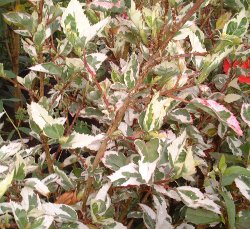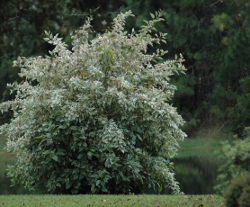S & J Nursery’s Guide to Growing
Hibiscus Snow Queen
in the Northeast Florida Landscape
( Hibiscus rosa- sinensis ‘Snow Queen’ )

Hibiscus Snow Queen / Hibiscus rosa-sinensis ‘Snow Queen’ Origins:
– Hibiscus plants are a long time southern staple in the landscape and a
favorite for potted gardens and indoor gardens in colder winter areas. The big bold blooms from spring all the way to fall add an instant tropical appeal to the landscape and are one of the showiest shrub or tree selections
available.
– Hibiscus rosa-senensis are often referred to as Chinese Hibiscus and are
thought to be native to tropical Asia.
WILL THE REAL SNOW QUEEN HIBISCUS PLEASE STEP FORWARD????
– I’m going to throw this in for the master gardeners out there, while most of us can not tell the difference unless they are sitting next to each other and even then the differences may need to be being pointed out, “Snow Queen” Hibiscus seems to me to be sold by reputable suppliers as two very
different hibiscus plants.
While both are obviously brightly variegated Hibiscus one has shiny leaves that are heavily “FLECKED”, almost like paint splatters with their variegation, the leaves are a bit smaller and the overall plant in the landscape is not as bright, but my Florida suppliers Snow Queen Hibiscus has a mat leaf ( no overly shiny leaves ) that has a green center and mostly an irregular edge of bright white variegation, not the “paint splatter” .
Both Hibiscus plants tend to pick up slight hints of pink to the foliage at
times, and both flower the same smaller red bloom with a slightly open habit and the typical 5 petals. Over the last 17 years, I have seen different Nursery Supplier Giants selling both of these pretty plants as Snow Queen,
so here in the top and bottom photo I have a photo of the Florida suppliers snow queen Hibiscus plant and the photo on the right is the only one I can find of the other shiny leaf “Snow Queen” as I do not have any in stock
and don’t run across them often, I can’t get a better photo but the link to the Monrovia nursery site at the bottom of the page shows this type of Snow Queen Hibiscus with much better photo’s and the Liner Source link
from Florida shows the one we will normally have in stock to sell. So until these two Hibiscus plants get sorted out by the plant brainiacs of the world, I will continue to just shrug my shoulders and call both of them Snow
Queen, leaving the problem for greater minds than mine to debate!
Hibiscus Snow Queen Preferred Exposure:
– Hibiscus Snow Queen can be planted in a full sun to partially shaded location in the North Florida | Jacksonville | St. Augustine area landscape. In My St. Johns county garden, I have my Red hot Hibiscus planted where they receive morning sun and afternoon shade from large pine trees, this allows enough sun for the beautifully decorative foliage to have great color but at the same time, the Hibiscus receives some cold protection from the trees during the winter months. Plants will bloom better in morning shade
and afternoon sun, but I think that the foliage of Red Hot Hibiscus is pretty enough to sacrifice some blooms to put it where I want it!
– Best if planted on the south side of the house away from cold north winds,
up next to a fence or near the foundation of a home or other building, or near larger shade trees that will protect these tropical plants from frost.
Hibiscus Snow Queen / Hibiscus rosa sinensis ‘Snow Queen’ Foliage:
– Snow Queen is a very brightly variegated hibiscus with soft green and bright white mottling on the leaves that can at times be tinged with slight hints of soft pink. Very pretty leaves, adds some color rather than just more green leaves!
– Foliage may or may not remain evergreen during the winter in our Northeast Florida area gardens, foliage is generally thought to be hardy to near 30 degrees and roots are hardy to 20 degrees. As with all tropical plantings, they are particularly responsive to their individual planting location. When planted on the south side of the house away from north winds, or where receiving some frost protection from larger trees or nearby buildings, hibiscus rosa-sinensis plants have been known to remain evergreen and blooming right in the middle of winter on one area of the yard and suffer complete foliage burn from frost in another.
All that fuss and Hibiscus will remain one of the most popular landscape plants available because despite their need for a little extra care during recovery after winter, hibiscus plants will be well worth the effort!
Hibiscus Snow Queen Soil Preference / Salt tolerance:
– Snow Queen Hibiscus plants will prefer well drained soils that are rich in organic matter. Amend the soil when planting with compost to help your northeast Florida soil hold both water and nutrients to keep the hibiscus healthy and blooming.
– Be sure to plant your hibiscus rosa-sinensis into a raised burm ( slightly
elevated mound 2-3 inches of even higher above the existing grade) in wet soils, they do not like wet feet and poorly draining soils is the fastest way to kill your hibiscus plants!
– Hibiscus rosa-sinensis are moderately salt tolerant and well suited to
coastal landscape plantings here in the Jacksonville and St. Augustine area landscape.
 Hibiscus rosa-sinensis ‘Snow Queen’ Size Variance:
Hibiscus rosa-sinensis ‘Snow Queen’ Size Variance:
– The foliage on the Hibiscus Snow Queen can reach heights of 8 ft or more in the tropics, but here in our Northeast Florida landscape they can easily be kept at 4-6 ft high and 3-4′ wide.
Hibiscus Snow Queen Growth Habit:
– Hibiscus rosa-sinensis ‘Snow Queen’ will form and upright mounded column of dense foliage and blooms.
Hibiscus Snow Queen Growth Rate:
– Slower growing in spring but quickly grows during the hot summer months even when trimmed down to the ground after a hard freeze.
Hibiscus Snow Queen Bloom:
– Blooms of the Snow Queen hibiscus are 3 inch wide bright red blooms with an elongated stamen.
– Flowers last only a day on most Hibiscus cultivars but new ones open each day to cover the plant in beautiful blooms!
Hibiscus Snow Queen Water Requirements:
– Although much more durable once established in the landscape, regular water is necessary to get the plant rooted and growing on its own after being planted in the ground from an S & J Nursery container. Water every day for the first week then every other day for the next week, and continue to taper watering black to a minimum of once a week or every time the top 2 inches of the soil is dry to the touch.
Best Uses For Hibiscus Snow Queen in the Jacksonville | St. Augustine Area
Landscapes :
– Hibiscus Snow Queen adds instant tropical appeal to any landscape setting.
– Use as a stand a lone garden specimen or in massed plantings to add flower color during spring summer and fall.
– Big bold color flowers grab attention anywhere you put them.
– Easy care plant for containers on pool decks, patio areas, walkways, home
entry accents etc.
Care of Hibiscus Snow Queen in the Northeast Florida Landscape:
– Amend sandy soils generously with compost to help your hibiscus get the much needed water and nutrients it takes to feed these ever blooming beauties.
– Water every day during the establishment period after planting in the garden from an S & J Nursery container. Be sure to continue supplemental irrigation during the hot summer months making sure to water when the top 2-3 inches of the soil has dried out.
– Fertilize these fast growing heavy flower producing shrubs often for best
results. A minimum of a good fertilizer application in spring summer and again in fall each year. Tropical plant food is best.
– When temperatures drop below 30 degrees you may opt to protect your foliage and stems from severe frost damage by throwing a blanket or other breathable fabric over the top of the plant making sure the edges touch the ground to trap in the heat from the soil.
– Make your last summer pruning in August giving your Hibiscus plant ample time to recover new foliage that will harden off before winter arrives for us here in late December. Pruning to late into the fall will cause flushes of cold sensitive new growth that is sure to freeze during even a light
frost that hardened off foliage would not be affected by.
– DO NOT REMOVE BURNT FOLIAGE UNTIL ALL DANGER OF FROST HAS PASSED. If you are like me, I just let the winter have at my hibiscus and deal with what I have left in the spring. If you choose this option, be sure not to remove any stems or leaves from the plant until we have reached the last average frost date and there are no late freezes being predicted. ( mid February for Northeast Florida is the average last frost date) Trimming burnt foliage and stems before then will leave bare branches deeper on the plant exposed to cold temperatures that would have been protected by those same stems and foliage if left unpruned and most often results in loss of the plant entirely.
-Trim off cold damaged foliage in spring after all danger of frost has passed.
Fertilize with a slow release garden food like Osmocote directly after spring pruning and again in summer and fall. Hibiscus are heavy bloomers and all those blooms quickly deplete nutrient stores, you may opt to fertilize
biweekly or monthly with a water soluble bloom fertilizer, just be sure to use the Osmocote as well to make sure the plant still has the nutrients it needs if you decide to stop feeding the flowers. I have really sandy soil
in my home garden and like to add a few shovel full of compost around the base of the plant underneath the foliage each spring, fertilize once a season with Osmocote and throw a handful of granular bloom booster every
once in a while if I notice that there are not as many blooms on the plant as I would like!

